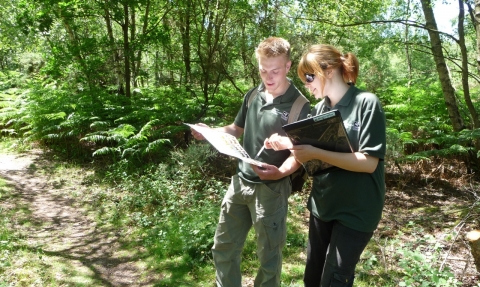
Monitoring wildlife
BBOWT's Reserves Surveying Programme
Surveying and monitoring habitats and species on our nature reserves - could you help?
To manage our nature reserves to their full potential we need to regularly assess the condition of the habitats on site, and have a record of all the key species present and how their populations are changing over time.
A rigorous programme of surveying and monitoring was launched in 2002 to standardise our approach. Each year we collect quantitative data using repeatable methodologies.
The Reserve Survey Programme aims to:
- Establish species presence/absence, species population trends and assess the condition of habitats
- Direct the management of reserves by reviewing the success of previous habitat management work and help plan for future management strategies
- Assess the impact of climate change
- Direct future surveying and monitoring programmes
- Inspire, train and involve volunteers
- Contribute to regional and national recording schemes, eg UK Butterfly Monitoring Scheme.
At the beginning of each year the Ecology Team plans more than 300 surveying projects for the forthcoming spring and summer survey season. Much of this survey work is carried out by a fantastic 'army' of experienced volunteer surveyors. Each surveyor is experienced in the identification of at least one species group.
How to become a BBOWT Volunteer Wildlife Surveyor
The Ecology Team is always on the lookout for new wildlife surveyors. If you are able to confidently identify one or more species groups (eg butterflies, dragonflies, birds or plants) and would like to help with the Reserves Surveying Programme, please contact Ro Turan on 01865 775476 or email volunteering@bbowt.org.uk for more information.
Most surveys are undertaken by the same surveyor every year. This helps with administration and with consistency of data collection and survey effort. However, every year new surveyors are needed to fill gaps when previous surveyors have retired or new surveys (eg on new reserves) have been planned.
Please note the survey allocation period for each year’s survey season is from late January to March. By late March all planned surveys have been allocated and surveyors have begun their survey work. If you miss this deadline, please still get in touch as you can be added to the surveyor list for the following year.
If you are keen to get involved but don’t think your identification skills are quite good enough yet, there may be the opportunity to take part in group surveying events. We can also recommend courses you may be interested in attending.
Summary of 2024 Reserves Surveying Programme
Colin Williams, Senior Ecologist, looks back at the highs and lows for wildlife on BBOWT nature reserves in 2024.
2024 was a difficult year for our native wildlife. In particular, many invertebrates suffered from poor spring weather and never really recovered even though weather conditions appeared to improve in the summer.
Many of my volunteer butterfly surveyors confirmed it was far and away the most disappointing butterfly season they can remember. I would agree! Butterfly Conservation announced a ‘Butterfly Emergency’ due to the very poor results from this year’s Big Butterfly Count. We also don’t really know how much the ongoing issues of atmospheric pollution, agricultural pesticides etc added to the problems this year.
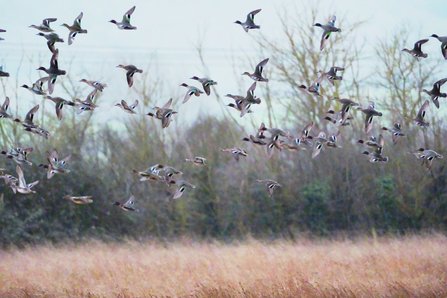
A flock of teal at Gallows Bridge Farm, part of the Upper Ray Meadows nature reserve. Photo by BBOWT volunteer Phil Gibbs
Wetland birds
On a personal level, a recent experience was the perfect antidote to an otherwise challenging year: A few weeks ago, I conducted a bird transect survey at Gallows Bridge Farm on the Upper Ray, when the site was in flood as a consequence of the torrential rain associated with Storm Bert. With large areas of shallow floodwater, the site was in perfect condition for wintering waders and wildfowl.
I watched a very active peregrine harassing a mixed flock of 1500 lapwing and 800 golden plover with the latter catching the low winter sun as they tried to out-manoeuvre the aerial predator.
As I continued on my transect route, numerous snipe, as well as a single jack snipe, were flushed from the wet grassland meadows. From the shelter of a dense hedgerow, I was able to count a vast raft of wildfowl loafing in one of the flooded meadows – 800 wigeon, 22 shoveler, 48 teal and 12 pintail.
It was one of the most enjoyable and productive bird transect surveys I have undertaken in my 16 years at BBOWT.
Reserve highlights and rarities
It is heartening to know, despite a difficult year, the results of this year’s Reserves Surveying Programme has revealed many encouraging wildlife highlights from our nature reserves.
All of this is testament to the fantastic work of our nature reserve volunteers and work parties, wildlife trainees and staff. Below are just a few of the highlights.
Penny Cullington from the Bucks Fungus Group collected an interesting specimen (‘small brown job’) at Rushbeds Wood in July. DNA analysis confirmed it was a 100% match for a newly described species, Pseudosperma maleolens (from Inocybe genus, Fibrecaps) and as such is a new species for the UK.
Penny and the Bucks Fungus Group have now recorded three new species for the UK from Rushbeds Wood in recent years!
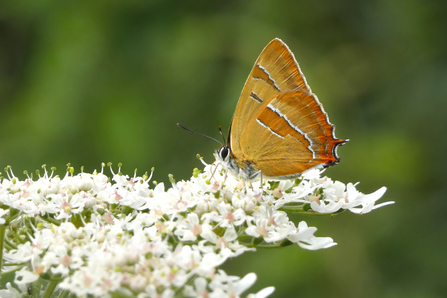
Brown hairstreak by Harry Huie
Butterflies
As previously mentioned, the butterfly survey season was very poor this year, however there were still a few highlights.
The season got off to a very encouraging start in January with a very impressive 201 brown hairstreak eggs found in the blackthorn hedgerows at Leaches Farm on the Upper Ray. This represents the highest ever count for the site.
On 15 February, Tony Croft found a large tortoiseshell on the wing at Whitecross Green Wood. This may well have been a released individual but could also have been a genuine migrant from the continent. Perhaps the species will recolonise the UK due to climate change?
Wall browns have almost entirely disappeared from our three counties after a very rapid decline in the last 20 years or so. However, there were a few encouraging records in our three counties this year, including an individual photographed during a butterfly transect at Greenham Common in August.
A brown hairstreak recorded on a butterfly transect at Gomm Valley in August was the first record for the reserve and the first for the wider area.
Damselflies
Willow emerald damselflies continue to colonise our area with an increase in records at Decoy Heath and the first ever record for Dry Sandford Pit.
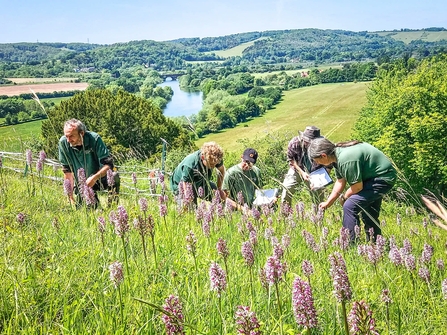
Surveys help to monitor the condition of nature reserves and inform how BBOWT manages them. Photo by BBOWT
Orchids
The orchid season was very mixed on our reserves. The first of the orchid counts was at Weston Turville Reservoir in May with 1879 early marsh orchids counted in the fen.
The following month, the orchid count day at Aston Clinton Ragpits recorded 19,143 orchids. The highest counts were – 6749 common twayblade, 6656 chalk fragrant orchid, 4753 common spotted orchid and 799 pyramidal orchid – a very impressive sight! The monkey orchid and monkey x lady orchid hybrids at Hartslock had a disappointing year.
Our two populations of military orchid remain very healthy with 370 counted at Swains Wood and 973 counted at Homefield Wood. The orchids at Warburg Nature Reserve suffered badly from slug damage during the very wet spring. However, our volunteer surveyors on site were able to confirm the presence of a single narrow-lipped x broad-leaved helleborine hybrid – the first ever known record. Orchids do love to hybridise!
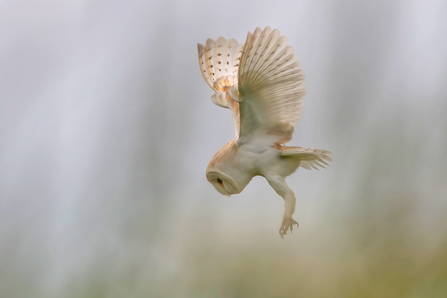
Barn owl by Wayne Weedon
Birds
The poor spring weather resulted in a difficult breeding season for many of our birds but there were still several noteworthy highlights.
After two blank years, two pairs of barn owls successfully fledged young at Chimney Meadows despite the continued frequent periods of flooding. Dartford warblers continue to increase at Snelsmore Common with fledged young noted for the first time for many years.
Up to six territories of nightingale were mapped at Hosehill Lake (or just beyond the boundary) with fledged young observed. 27 nightjar were recorded at Greenham and Snelsmore Commons on 21 June which is the highest ever count for a single survey date.
A pair of oystercatchers adapted to the flooding at Duxford Old River, part of Chimney Meadows, by successfully nesting on top of a rotten fence post!
As expected, our reserves played host to several scarce migrant birds. A black-winged stilt at College Lake in spring must have looked very exotic and a white-winged black tern which lingered at Hosehill Lake in October was seen by many Berkshire-based birders.
The undoubted highlight was spotted at Warburg on 31 October. Whilst taking a well-deserved break during a work party event, a volunteer spotted an unusual bird of prey overhead associating with the local red kites. After much deliberation and discussion, the bird was provisionally identified as a dark morph booted eagle.
The news was released on the national birders’ grapevine and the following day it was relocated 6km away at Remenham Hill. For the two days the bird remained in the area, it is estimated 300 visiting birders got to see the bird. There have been a few previous unsubstantiated records in the UK, however, it is expected this well-photographed individual will be accepted by the national rarities committee and represent the first UK record.
Unusual insects
We are fortunate to have some excellent entomologists regularly visiting and recording on our reserves.
A robberfly photographed by Peter Creed at Dry Sandford Pit way back in September 2012 remained unidentified for many years. During the production of the forthcoming ‘A photographic Guide to Flies of Britain & Ireland’, it was finally identified as the nationally rare robberfly Neommochtherus pallipes. It was first recorded in Britain in 1990 in Devon and the only other known site for the species is in Shropshire.
Sue Taylor has been responsible for numerous interesting records on our reserves. Sue collected a couple of specimens of parasitised brimstone caterpillars in spring and one hatched as Hyposoter rhodocerae and is now part of the Darwin Tree of Life project (darwintreeoflife.org).
The second turned out to be a hyper-parasitoid which Gavin Broad at the Natural History Museum has provisionally identified as Mesochorus olerum and is now part of the NHM collection.
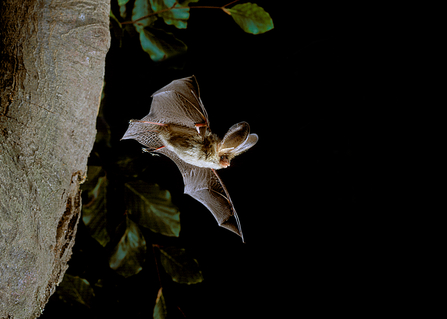
Brown long-eared bat by Hugh Clark
Bats
A survey to establish the bat species inhabiting Moor Copse involved the use of static detectors at four locations on the reserve from May to October.
An impressive twelve species were identified - Alcathoe, western barbastelle, Brandt’s, brown long-eared, common pipistrelle, Daubenton’s, Leisler’s, Natterer’s, noctule, serotine, soprano pipistrelle and whiskered.
In addition, eight species of small mammal were also identified, including hazel dormouse and water vole.
Reserves Surveying Programme
A fantastic army of 135 volunteer surveyors helped undertake 285 planned priority surveys on 69 of our nature reserves in 2024. The data collected will continue to help inform our habitat management work as well as contribute to regional and national recording schemes.
Without the help of our surveyors, we would have far less knowledge of the species present on our reserves, how their populations are changing over time, as well as the condition of our key habitats.
In 2024 we undertook 39 butterfly transects, 37 bird transects, 9 dragonfly transects, 54 habitat condition assessments as well as many other surveys and monitoring projects such as dormouse box checks, orchid counts, badger activity monitoring, groundwater level measuring, newt bottle-trapping, reptile refugia checks and bat monitoring.
The results of survey data - collated by our Ecology Trainees, Hayley and Vicky, as well as our office volunteer Bob - are shared with the various BBOWT Land Management Teams. We also provide our data to several ongoing external recording schemes such as the UK Butterfly Monitoring Scheme and the People’s Trust for Endangered Species’ National Dormouse Monitoring Programme.
Eight surveyors completed their 10th year of volunteering for the Reserves Surveying Programme this year. Since the programme started, 95 surveyors have completed 10 years, and a further 13 surveyors have completed an incredible 20 years or more!
At this year’s AGM, it was great to be able to present Lifetime Achievement Awards to John Melling and Graeme Stewart and an Outstanding Achievement Award to Steve Keene. These fantastic volunteers have contributed to the Reserves Surveying Programme over many years as well as to many other areas of BBOWT’s diverse work.
Get involved
Many thanks to our existing and new surveyors. If you haven’t been involved in the Reserves Surveying Programme and you have wildlife identification skills, please get in touch with Senior Ecologist, Colin Williams, to find out more.
Your wildlife sightings on BBOWT nature reserves
As well as the more formal Reserves Surveying Programme, we are also always keen to receive any ad hoc wildlife records.
If you have wildlife records collected on BBOWT nature reserves that you would like to share with us, please contact data@bbowt.org.uk.
We share biological records with our local record centres, which helps to inform local and national decision-making that may impact on biodiversity and conservation.
Please submit any records that are not from BBOWT nature reserves directly to BMERC if the records were in Buckinghamshire, or to TVERC if the records were in Oxfordshire or Berkshire.
If you've seen some interesting wildlife when you've been out and about, you can let us know via Twitter, including @BBOWT in your tweet.
Water voles, American mink and otter sightings
If you've seen a water vole, American mink or otter anywhere in Berks, Bucks or Oxon, please email your sighting to watervole@bbowt.org.uk, including the date and location of the sighting (with a grid reference if possible).
Volunteer by Jess Gallagher
Volunteering opportunities for all
Find out more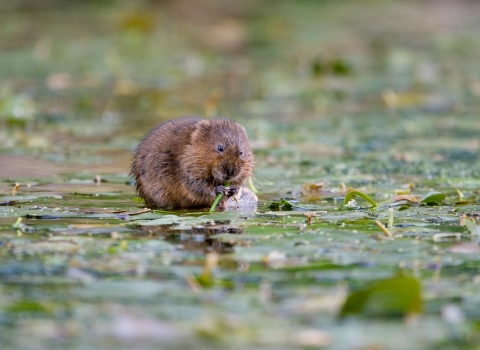
Water Vole Recovery Project
Find out more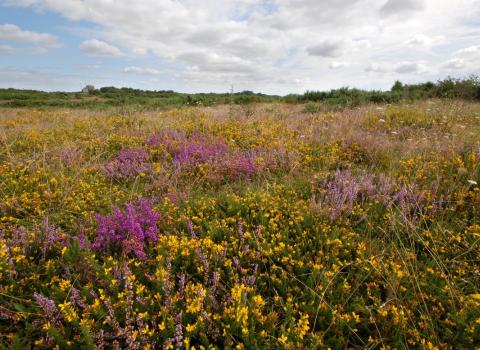
Heather and gorse at Greenham and Crookham Commons. Photo: Rob Appleby
